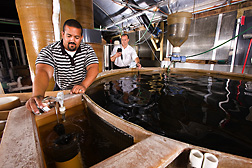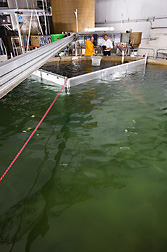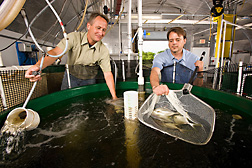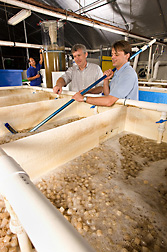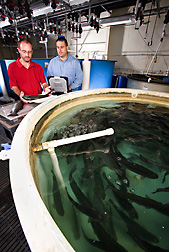Recirculating Water Helps Aquaculture
Laboratories in the Agricultural Research Service’s aquaculture program are working well together. In developing recirculating systems for fish production, ARS labs in West Virginia and Maine are working with the Conservation Fund’s Freshwater Institute (FI) in Shepherdstown, West Virginia, to find out how best to produce fish that live in cool and cold water.
Also, an ARS researcher in Stuttgart, Arkansas, has developed recirculating systems that address the needs of warm-water marine species.
A (Recycling) Splash of Cold Water
A research partnership between ARS and FI has refined a new model for fish farming, one that can produce healthy fish, leave a healthy environment, and be done almost anyplace, even far from large water resources.
The research, carried out through a cooperative agreement between the U.S. Department of Agriculture and FI, has pioneered ways to best produce cool- and cold-water fish in the tanks of a water-recirculating fish farm. Says Steven Summerfelt, director of aquaculture systems research at FI, “The recirculating systems developed here have several advantages over net pens and flow-through culture systems. Because they require far less water and capture the wastes, a fish farm that recirculates its water can be located far from large water bodies and near consumers. That gets fresh fish to market faster and with less transportation cost.”
|
|
Fish that require pristine water conditions were once thought to be too difficult to grow in tanks supplied with recirculating water. Trout are a prime example. Particularly sensitive to water quality, they will not eat enough feed to grow if conditions aren’t right. But they are in high demand as food. So ARS and the team of problem-solvers at FI have taken a systems approach and designed fish-farming systems that address stocking of fish, waste removal, biosecurity, water-quality monitoring, and fish harvesting step-by-step, so that trout and many other high-quality market species will thrive in water-recirculating systems.
“Twenty years ago, it was believed that trout couldn’t thrive in a water-recirculating system,” says Summerfelt. “But we have now developed systems that maintain water clean and fresh enough for trout, salmon, and Arctic char to grow and thrive.”
Summerfelt says the systems have additional advantages over traditional fish-culture technology. “They prevent fish from escaping the farm, treat waste to avoid polluting the watershed, and recapture nutrients for other agricultural uses,” he says. “We have also nearly eliminated chemical and antibiotic treatments, because these nearly closed systems effectively exclude fish pathogens. Our biggest challenge has been to make these new technologies more cost-competitive against traditional net-pen, pond, and flow-through fish-culture technologies.”
At this point, Summerfelt says, “specific high-value niche species are being farmed in water-recirculating systems. But we expect that domestic production of many fish species, including salmon, will eventually become competitive in domestic, large-scale, land-based, closed-containment aquaculture systems.”
|
|
William Wolters, director of the National Cold Water Marine Aquaculture Center in Franklin, Maine, is impressed. They use a water-recirculating system developed at FI for Atlantic salmon.
“The recirculating systems are working very well,” says Wolters. “In our area, there are limited ground-water resources, so we need this system to reuse water. We have been able to raise our fish efficiently with that limited amount of water.”
In addition, research leader Caird Rexroad III, geneticist Timothy Leeds, and physiologist Gregory Weber, at the ARS National Center for Cool and Cold Water Aquaculture (NCCCWA) in Leetown, West Virginia, maintain a broodstock-development program in which fish are produced in recirculating systems developed by Summerfelt. In 2008, a new facility based on this technology was completed, and it now houses the entire life cycle of the NCCCWA broodstock, which are evaluated for production efficiency.
Recirculating systems from FI use as little as 4 percent new water each day, which means that a complete water exchange takes place once every 25 days. This miserly use of water, an environmental plus, also allows recirculating fish-farm systems to be located in many places where traditional aquaculture wouldn’t work.
NCCCWA and FI scientists are also determining how different fish feeds affect fish performance and health and water quality. Open-formula, fishmeal-free trout feeds, developed by ARS fish physiologist Rick Barrows at the Hagerman Fish Culture Experiment Station in Hagerman, Idaho, and by his colleagues, result in fish performance equal to that obtained with current industry-standard diets containing much higher levels of fishmeal. Furthermore, the fish waste—a major source of phosphorus and nitrogen pollutants—is firmer, allowing it to settle quickly out of the system. Waste removal is important for maintaining water quality.
“Dr. Barrows’s alternative diets work well in recirculating systems. The fish grow just as fast, but they have better fin condition, and we can maintain excellent water quality,” says Summerfelt.
Frisky Warm-Water Marine Fish
Further south, other ARS scientists have also successfully developed recirculating sys-tems. Agricultural engineer Timothy Pfeiffer, based at the Harry K. Dupree Stuttgart National Aquaculture Research Center, in Stuttgart, Arkansas, conducts his research at the Aquaculture Park of the Florida Atlantic University/Harbor Branch Oceanographic Institute in Fort Pierce, Florida. He has evaluated recirculating systems for various marine fish, including cobia, red drum, sea bass, and pompano. Pfeiffer used Florida pompano in his most recent studies to determine the fish’s response to low-salinity water at high density in recirculating systems. Pompano is a high-value, fast-growing fish found in waters of the U.S. eastern seaboard from Virginia to Florida. They can attain a length of up to 12 inches in the first year of life.
Pfeiffer concentrates on evaluating various components of the recirculating system and the efficiency of the system’s unit operations—solids removal, aeration, carbon dioxide removal, biofiltration, and disinfection. Different system components and operational strategies affect the system’s water quality and, ultimately, the mass of fish that can be cultured in the tanks.
|
|
In recirculation systems, energy is a major cost factor, so research to reduce the energy demands is critical. One energy-intensive operation being examined for modification is water pumping. Recirculating aquaculture systems mainly use centrifugal pumps to move water throughout the system treatment components and tanks, which requires high energy input.
One of Pfeiffer’s studies of recirculating systems for pompano production evaluated high-head versus low-head pumping systems to determine energy requirements and how many fish could be maintained within each system. High-head systems refer to high-pressure centrifugal pumps, and low-head systems refer to low-pressure axial flow propeller pumps.
“We found that use of low-head pumps with proper system plumbing, minimal bends in the pipe, and larger diameter pipes requires less energy, which can make the enterprise more sustainable,” says Pfeiffer. “A properly designed low-head system with an axial flow pump can use up to 30 percent less energy than a high-head centrifugal pump system.”
Stocking density of fish was also investigated. Traditional pond culture without water recirculation generally operates at densities of 0.005 to 0.007 pounds of fish per gallon of water. “We are able to maintain as high as 0.5 pounds of fish per gallon of water,” says Pfeiffer. “We want to push our capacity to 0.75 pounds per gallon, on par with the most efficient systems known, and we expect to achieve that capacity with some design modifications.”
The tanks were 10 feet in diameter and 4 feet deep, holding about 2,000 gallons of water. “All the systems are automated to monitor and control oxygen concentration in the tanks and feed fish,” says Pfeiffer. “These systems can be applied to either freshwater or saltwater fish culture.”
In addition to investigating recirculating systems for the grow-out phase, Pfeiffer also investigated recirculating-system designs for hatchery production. “We constructed two hatchery multi-tank systems that use air to lift and circulate water in the tank,” says Pfeiffer. “The air-lift pumps produce bubbles that lift the water as they travel upward through the water column, achieving circulation, aeration, and degassing all in one action.”
Recirculating aquaculture systems have a bright future. Their advantages—a controlled environment that optimizes growth and protects against pathogens and disease, a reduced water requirement, and the ability to remove and reuse animal wastes—make these systems able to provide a continuous supply of fresh, healthy fish to those in and near land-locked areas as well as those near the coast. As energy efficiency increases and the control offered by recirculating systems becomes more valuable, these technologies will grow in use.—By Sharon Durham, Agricultural Research Service Information Staff.
This research supports the USDA priority of ensuring food safety and is part of Aquaculture, an ARS national program (#106) described at www.nps.ars.usda.gov.
Caird Rexroad III is with the USDA-ARS National Center for Cool and Cold Water Aquaculture, 11861 Leetown Rd., Kearneysville, WV 25430; (304) 724-8340 ext. 2101.
Tim Pfeiffer is with the USDA-ARS Harry K. Dupree Stuttgart National Aquaculture Research Center, 5600 Hwy. U.S. 1 North, Fort Pierce, FL 34946; (772) 465-2400 ext. 360.
Rick Barrows is in the USDA-ARS Small Grains and Potato Germplasm Research Unit, Hagerman Fish Culture Experiment Station, University of Idaho, Hagerman, ID 83332; (208) 837-9096 ext. 1109.
Steven Summerfelt is with the Conservation Fund’s Freshwater Institute, 1098 Turner Road, Shepherdstown, WV 25443; (304) 876-2815 ext. 211.
"Recirculating Water Helps Aquaculture" was published in the October 2010 issue of Agricultural Research magazine.







